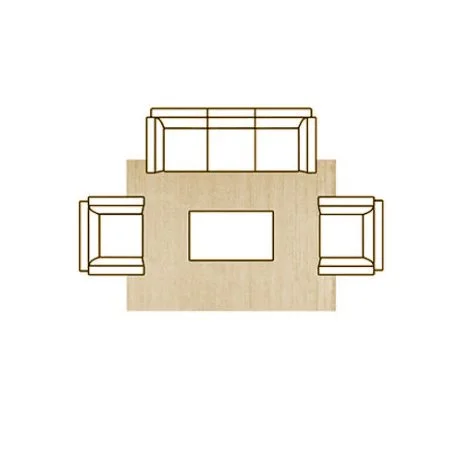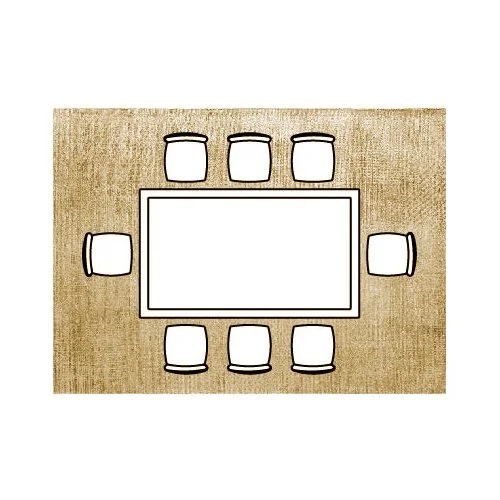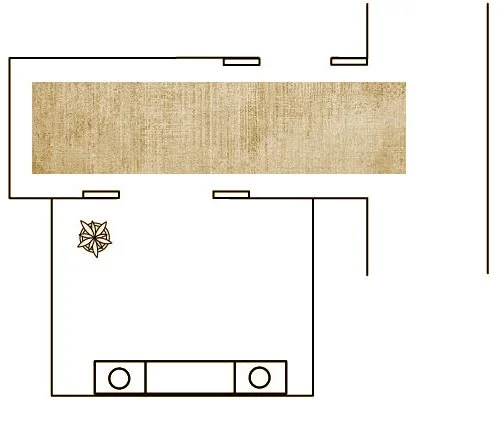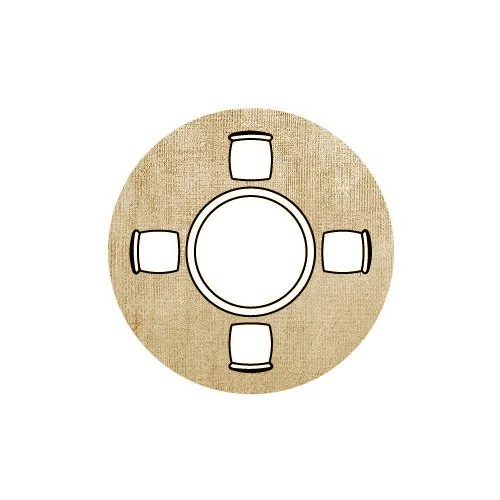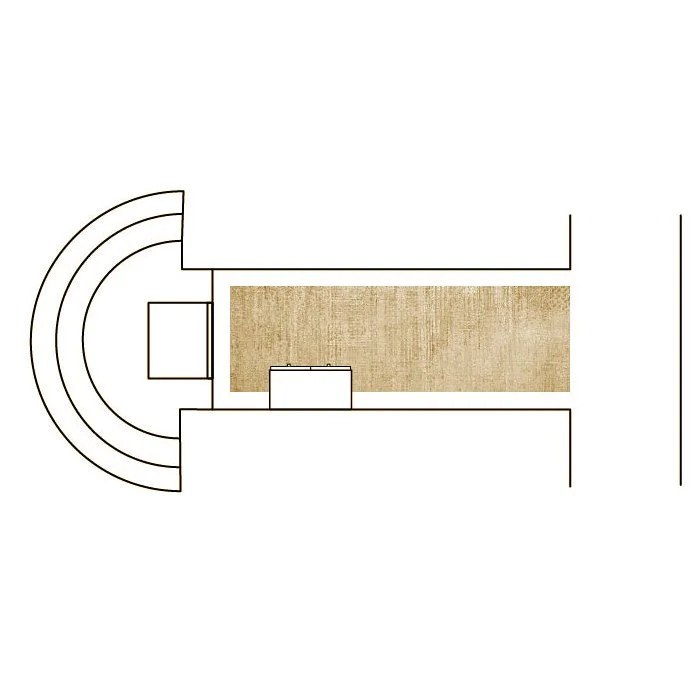Shapes, Sizes & Spaces
-
Ideal For:
Living Room
Bedrooms
Entryways
Offices
Common Sizes:
3’x5’ - 4’x6’ (190x150 - 120x180 cm)
5’x8’ - 6’x9’ (150x240 - 180x270 cm)
8’x10’ - 9’x12’ (240x300-270x360 cm)
10’x14’ - 12’x15’ (300x427-360x460 cm)
-
Ideal For:
Living Room
Bedrooms
Offices
Dinettes
Common Sizes:
4’ (120 cm)
6’ (180 cm)
8’ (240 cm)
10’ (300 cm)
-
Ideal For:
Bedrooms
Hallways
Common Sizes:
2’-6” x 6’ (76x183 cm)
2’-6”x8’ (76x244 cm)
2’-6”x10’ (76x305 cm)
2’-6”’x12’ (76x360 cm)
At Supermarket Studios we are experienced in providing custom runners at any length. Please inquire.
-
Ideal For:
Living Rooms
Dining Rooms
Common Sizes:
4’x4’ (120x120 cm)
6’x6’ (180x180 cm)
8’x8’ (230x290 cm)
10’x10’ (240x240 cm)
-
Rugs can be hexagonal, octagonal or even triangular; these can either include geometric crystals with asymmetrical angles, to curvy hand drawn forms.
Get inspired by our Silhouettes!
Ideas:
Octagon (Entry, Dining Room)
Semi-Circle (Entry)
Kidney (Living Room)
Amorphous (Living Room, Bedroom)
If you have a creative shape in mind, please reach out to us.
Measure Before You Start
Before you start looking at rugs you need to measure the dimensions of your room to work out the approximate space you have for a rug and any constraints you have (door openings, etc).
Spaces
Living Room
For living rooms, you have a few a different options when it comes to placement. First, be sure to measure your space and your furnishings.
Tip #1: With wooden flooring, it is best to choose an area rug which lets about eight inches (twenty centimeters) of wood to be exposed around the rug’s borders.
Tip #2: More than 2 area rugs can also be placed in some large living rooms.
Standard Sizes: 4’x6’ & 5’x8’
If the room has a coffee table then small rugs would be most suited for this space.
With a small rug, you can treat it as a centrepiece, with the furniture surrounding the rug. This is a great option for when you don’t want to hide any part of your beautiful new purchase, and is also an economical choice as you don’t need as large a rug.
Bedroom
Bedroom rugs are all about having a plush feeling underfoot when you step out of bed in the morning, so placing your rug so that you have approximately 60-70 cm next your bed is ideal. Side tables should be completely on or completely off the rug so they are stable – to achieve this the rug can be placed just in front. An economical option would also be two runners either side.
Tip #1: Place an area rug at the foot of the bed and two runners on each side, for a cozier foundation.
Tip #2: Several smaller rugs can be scattered to fill the space as needed.
Standard Sizes: 3’x5’ or 8’ Runner
Instead of a room-sized area rug for the bedroom; use multiple area rugs. Bigger rugs in bedrooms will get hidden under the bed.
Standard Size: 8’x10’
For seating areas accommodating 4-6 chairs.
Standard Sizes: 2’x3’, 2’6”x8’ and 3’x5’
Bigger is Usually Better
A small rug can make a room look small and its elements disconnected. When in doubt, go for a bigger size to help tie everything together.
Standard Sizes: - 6’x9’ and 8’x10’
For smaller spaces, take a “two legs on, two legs off” approach. This still allows for plenty of rug coverage, and is great for showcasing more colour or design. If furniture is kept against the wall, the rug must be placed such that the front two legs of the furniture remain on the rug.
Standard Sizes: - 8’x10’ (queen) and 9’x12’ (king)
If you chose an area rug to go under the bed, it should extend around 3 feet or so, all around the bed. Alternatively, it could also extend on the sides and not on the foot of the bed.
Standard Sizes: 30" to 42” Width / 6’ to 12’ Length
The 18-inch Rule
Most interior designers will tell you to leave around 18 inches of bare floor around a rug to get the right proportions. However, for small spaces you can tweak this.
Standard Size: 9’x12’
For seating areas accommodating 6-8 chairs.
Experiment!
You’re allowed to bend the rules a bit when choosing a rug – they’re only guidelines after all.
Standard Sizes: - 9’x12’ and 10’x14’
You can select a rug that is larger than your living room set – this is great for defining open plan spaces, large rooms or for when you want to make a statement.
For big living rooms with furniture in the center, a large rug is best suited. This rug will help in fitting the furniture on top without getting overcrowded.
Oversized / Custom
For more of a “wall-to-wall” look and feel, experiment with oversized or custom sized carpets.
Dining Room
Area rug should be large enough to accommodate all chairs. The back legs of the chair must remain on the rug when the chairs are pulled out - anything smaller will catch on the chairs. Choosing a shape that mirrors your dining table is a great way to frame your dining space.
Tip #1: From edge of table, extend the rug roughly 30”.
Tip #2: Choose a stain-resistant material such as wool.
Standard Sizes: 8’ or 10’ Oval, Round or Square
For oval, round or square tables.
Hallways & Entrances
A runner, made of wool, can be placed in the center of hallways. Wool runners are durable in this high traffic area. With hall runners, always leave allowance for your door to swing open, and be sure to take into account architraves and skirting boards that may jut into the hallway. Leaving some space either side of your runner is recommended to have the floor frame the rug. Be as generous as the space allows, as a narrow runner can be awkward to walk on.
Tip #1: Very light colors usually do not suit this space.
Tip #2: A runner can also be kept on one side of the hallway or aisle and the furniture can be placed against the opposite wall.
Kitchen
Runners are the best choice for narrow kitchens. They fill up the space and remain soft under feet.
Tip #1: Place a small rug in front of the sink if there will be high traffic.
Tip #2: Choose a carpet with low pile or even zero pile for easy cleaning.






